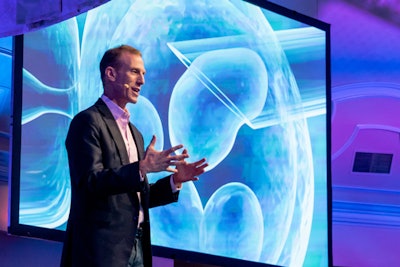
Jamie Metzl is a technology futurist and geopolitical expert, novelist, entrepreneur, media commentator, and senior fellow of the Atlantic Council who is a regular keynote speaker at high-profile events including Google Zeitgeist, SXSW, and Tech Open Air.
After years of giving keynote talks at corporate events and board meetings around the world I’ve seen firsthand how outside speakers can provide invaluable new perspectives to any meeting and organization, inspiring corporate communities to think more expansively about their industry and the world and to engage with each other differently. Unfortunately and all too often, however, I’ve also seen how regularly companies and event organizers underuse the speakers they hire.
As someone who both speaks on the big-picture implications of new technologies and curates small groups of experts to explore these types of issues, I’ve often asked myself how I would use a hired speaker if I were the event organizer rather than the speaker. I do this type of work for companies but my approach is not a trade secret, just a best practice I’m happy to share. Because when companies have great experiences with speakers it’s good for the companies, the speakers, and the advancement of ideas.
So here is my list of principles for companies to better engage and use the speakers they have hired.
1. Place the speakers in context.
Before a speaker even shows up, your organization can lay the foundation for future success. In advance of the talk, attendees should be given concise background materials on the speaker and the key issues that will be discussed. Wherever possible, prospective attendees should also be given a short and thought-provoking reading and a few big questions to think about. This will help focus their energy for when the speaker arrives.
2. Invite speakers on a journey.
Speakers brought in to give a single one-hour talk can be a wasted asset if not engaged more broadly. To get to your event, the speaker has already often taken a day or more away from home, so why not pull them into your process more deeply? In addition to giving talks, speakers can lead smaller discussion sessions for more interested participants, meet with executives to explore a particular issue in greater detail, answer questions posted on screens in a common area, and make other contributions. The more the speakers are engaged the better it is for everyone, including the speakers themselves. Rather than creating a “one and done” engagement with the speaker, build a relationship with the speaker to come back over two or three years so that the ideas explored and relationships made can deepen over time.
3. Better organize and democratize the Q&A process.
Even the greatest talks can be brought down to earth when they are followed by boring and poorly-structured Q&A sessions. These sessions often follow the same pattern of young staffers running around with mics reaching people who ask randomly organized and sometimes poorly formed questions that may or may not be of use to anyone else. Rather than stick to this sub-optimal formula, organizations should ask participants to submit their questions from their phones and vote on the questions they want to see answered through the conference app or other technology. That way the questions of greatest interest to everyone can be asked by a moderator and answered by the speaker.
People who want to make a public comment can also stand up and do so, but each should be allowed only one sentence. Mics should be carried around the room not by interns or junior staff but by senior executives of the host organization working in concert with the moderator. This makes clear that the conversation is of, by, and for everyone.
4. Continue the dialogue.
Speakers should not just be information and idea providers but also conversation catalysts. There are lots of great ways to foster follow-on conversations among event participants after a talk. One is to seat people in circles and give them a single question to discuss immediately following the talk. Another is to host a moderated electronic conversation on the conference app following the presentation. Countless other approaches will also work. The key point is that to be most effective the talk should be the beginning of a longer process of dialogue and engagement. Companies should think of their speakers as longer-term idea, creativity, and conversation catalysts rather than just entertainers.
5. Build community around the ideas.
Any good talk will raise questions and inspire new ideas. Your job as the organizer is to make it as easy as possible for event participants with similar or related interests to easily find each other. One simple way to do this is by setting up and allowing event participants to set up sub-communities on Slack or similar apps. They can then communicate with each other through the app, connect to each other during receptions using the geo-locators in their phones, and keep in touch after the event. For people participating in the conference remotely, this effort offers them more engagement.
6. Connect big ideas to your event and corporate goals.
Event organizers who think of high-profile speakers as brainy entertainers lose out on the greatest contribution a speaker can make. In our exponentially-changing world, creativity and ideas are the most essential ingredients for success. But big ideas can’t be like clouds floating away. They need to be explored, harnessed, and embraced. After a great speaker has inspired event participants to think differently about their future, event hosts should help participants think more deeply about how to make these new insights actionable. While this is easy for simple “how to” talks, it’s more challenging—but also more rewarding—following talks exploring broader and more mind-expanding concepts.
To get the most out of a speaker, all of these principles should be deployed as part of an integrated engagement strategy. Extra effort on the part of event organizers can translate into a radically transformed experience for event participants. Take it from a veteran speaker.



















